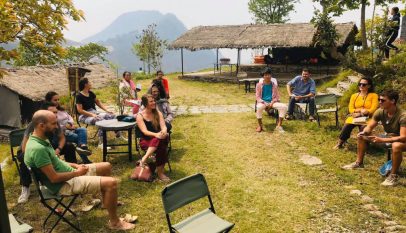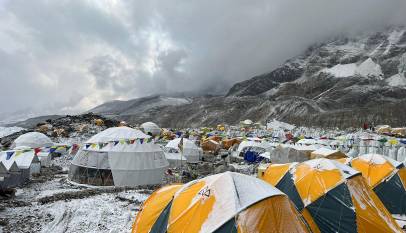Tourism plans and prospects of Gandaki Province
- Prithvi Subba Gurung

Pokhara: Gandaki province is home to various best tourist destinations in Nepal as Gandaki is very rich in natural heritage and cultural diversity. Some of these cultural heritages have substantially contributed to the mainstream Nepali culture.
Since Gandaki is rich in both culture and natural beauty the province is the most appropriate place for the tourist destinations. We call Gandaki as the confluence of “nature and culture”.
Tourism here is the main vessel of alleviating poverty, promoting the prosperity of the province and people with the least investment in it as it can contribute to the productions of products.
Bridging gap between town and village
We declared the year 2019 as the internal visit year because the domestic tourists also play a significant role in boosting the tourism sector. So we prepared our policies and programs for this year in 2018 and declared the year 2019 as the internal visit year.
Our government at the policy level decided to promote at least 300 homestays in the next five years to create jobs, promote economy, alleviate poverty with the diversification of the tourism by taking it to the rural areas where the local economy can be promoted through a focus on village tourism.
We also called upon our people to apply for the construction of homestays. Our appeal was so overwhelmingly welcomed that we received over 300 applications in the context of promoting homestays in the province.
People are confident and hopeful that they can run the homestays if the provincial government supports them in their endeavors. So far our provincial government has endorsed 274 homestay applicants out of 300 received as per certain criteria set for it.
The criteria are that at least there must be a cluster of 10 homes to run a homestay at a place. And once the government promotes such homestays, the benefits should go to the local poor households.
We have urged the local people to protect culture, identity and gain economic prosperity and enhance local productivity such as producing eggs, chickens, sheep, buffaloes, etc. We have found this program very effective as new homestays at various places have started operating well.
 Sirubari is the first homestay initiated for the first time in Nepal. Then Ghalegaun was the second homestay initiated after registration. Both of these homestays have already been awarded by the village tourism sector for being pioneering homestays.
Sirubari is the first homestay initiated for the first time in Nepal. Then Ghalegaun was the second homestay initiated after registration. Both of these homestays have already been awarded by the village tourism sector for being pioneering homestays.
We have asked our tourism ministry to prepare all documentaries, short leaflets, brochures about all 274 homestays and 110 tourist destinations. We have also started giving training to the homestay runners by bringing about 2-3 participants from each of the homestays to know about how to keep homestays, how to make the tourists happy, how to cook foods, how to keep the environment clean and how to give the good hospitality to the tourists. Now we have plans to connect all homestays with agriculture too.
We will have our roadmaps implemented. I know that all the homestays are not the same due to different cultures, different communities, and different places. All homestays can’t function the same way as others. Only the food items can be the same.
Some homestays may have plenty of organic foods like barley, wheat and historical places to visit for the tourists. Fresh apples may be there in the trees which can be plucked and eaten fresh by the tourists.
Differences occur as we have seen the way tourists are welcomed and bid Farwell at Kaulepani is not the same at the Ghalegaun. If we go to Bandipur it is different.
What local tea Ghalegaun homestay can give to the visitors cannot be given by Bandipur homestay? The variety must be there as a spice. They (local homestay runners) should also discuss these topics. Look at five-star hotels. All hotels give food but the manner of giving good and ingredients of food may be different.
 So, our homestays should be different in their contents depending upon the community, culture, religion and the place where the homestays are being run. Homestay is only one segment of village tourism where we try to take tourists to the villages to bridge the gap between tourism in the town and the rural areas.
So, our homestays should be different in their contents depending upon the community, culture, religion and the place where the homestays are being run. Homestay is only one segment of village tourism where we try to take tourists to the villages to bridge the gap between tourism in the town and the rural areas.
Plans for mainstream tourism
As Pokhara is developing an adventure tourism hub, we are also planning to manage water-related sports in Fewa Lake and other lakes of Pokhara besides adventurous sports like Paragliding, Ultralights, Bungee jump, etc which tourists can enjoy and not elsewhere.
Likewise, we are also planning to call a meeting of religious groups and cultural groups to prepare a tour package on pilgrimage tourism and festival tourism.
Mountaineering in Nepal generally means only going to Khumbu valley. We have not been able to market and benefit from the higher peaks like Annapurna, Dhaulagiri, and Manaslu located in our province.
Dhaulagiri can be a challenging climbing for those who wish to adventure with the challenge of climbing. So, we need to take more climbers to ascend these peaks.
We are also thinking of discovering new alternative trekking routes. We are thinking of ways to use cable cars up to Manaslu, Annapurna, Dhaulagiri base camps in the future as helicopter sightseeing has polluted the environment as it adversely affects the birds and animals in the region.
 We are also planning to make a triangle connection between Pokhara, Saurah, and Lumbini by any means. The travel, tour, and trekking have not been able to make total tour packages. The package tour related to seeing of sunset, sunrise, etc have not been prepared and sold accordingly.
We are also planning to make a triangle connection between Pokhara, Saurah, and Lumbini by any means. The travel, tour, and trekking have not been able to make total tour packages. The package tour related to seeing of sunset, sunrise, etc have not been prepared and sold accordingly.
We need to connect ourselves to the world which I think will start as soon as the international airport will be launched in Pokhara in 2021. We want a way to bring tourists directly to Pokhara from domestic cities as well as cities of neighboring countries. For the long term vision, we are making a provincial tourism master plan.
Equal impetus on international and domestic tourists
We are giving equal impetus to both international as well as domestic tourists. People going to Manang and Mustang can contribute to internal tourism is our new concept in Gandaki. Even the people visiting homestays are our domestic tourists. Even internal tourists are capable of spending more money. So, our priority is focused on internal tourists.
We also need to spread information about the most popular homestays of Gandaki. 3800 meter high Muktinath is located in our Gandaki and Damodar Kunda is also situated here. Today our people go to Bangkok and Bali to worship in the temples. It would be worthwhile if they worship at Muktinath and Manakamana temple here in Nepal instead of going abroad.
Why should we go to Bali? What we don’t have here is the ocean only which Bali has. The rest of the things are with us. That’s why to let our people know about their domestic destinations we declared the year 2019 as the internal visit year.
Focus on Neighbors
Now we will get ready and declare the year 2020 as the visit year for the promotion of tourism for our neighbors. During this process, at least 20 million people will come out of their homes.
Gandaki province can easily bring about 3-4 million tourists from China, India, SAARC and European countries. So, in 2020 we will market our tourism in China and India by going there and advertising our campaigns in their language through their channels.. We can have additional benefits if we go to Bangladesh too.
We plan to bring in at least 2 million tourists in 2022 after the international airport is opened in 2021. We will give importance to tourism infrastructure also. If we succeed in implementing all these plans then our future individual per capita income will be over 2000 dollars.
Priority on Security and Environment
The most important thing for visitors is security. Now we are planning to open rescue centers for travelers and trekkers and to open mobile hospital centers to ensure the security of the tourists. We also assume that the increased flow of tourists may cause the environment degradation.
Gandaki province has the maximum conserved area of forest. It has 37% of the forest area. Some of the areas of Chitwan also fall in our area. We want to declare a Manaslu round conserved area in totality by including some areas of Gorkha. Dhaulagiri, Annapurna, and the Manaslu area should be conserved to protect the environment and tourism.
Development of Human Resource
Due to the lack of proper human resources, we could work with the expected tempo in the past. The civil servants deputed to this province have also not yet arrived. We are thinking of establishing an office for the Directorate of Tourism which will look after all these tourism-related issues.
We also need to promote Chinese guides and officials for the front desk at all tourism sectors in Gandaki. We will start a Gandaki technical school in the future which will deal with all subjects required for the preparation of human resources to deal with the tourism sector.
– This article is based on a conversation with Prithvi Subba Gurung, Chief Minister of Gandaki Province.
Foreign Tourists Flock to Himalayan Routes
During this period, the main trekking routes of the Annapurna region were visited by 79,23…









